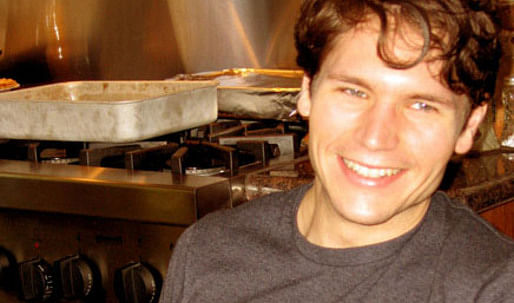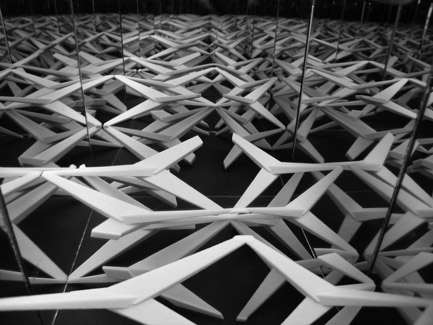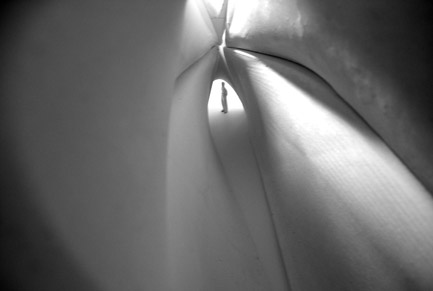

Editor's note: When you think about it objectively, the community of architects is surprisingly small. This summer, William Cooper Mack (April 2, 1982-June 3, 2008), a promising young American architect working in London, succumbed to Leukemia, leaving our community a little bit smaller still. Recorded below is a memorial to Cooper, written by his professor and mentor Anthony Vidler, accompanied by images of Mack's work currently installed as an exhibition at the Cooper Union Architecture School gallery. The public is invited to visit the exhibition which will be on view until September 26th. - Bryan Boyer

William Cooper Mack began his career at the Cooper Union in the School of Art, where he studied for one year before transferring to the Architecture School. He was never to lose that sensibility for the right form of things, a search that led him equally to the complex structural geometries he explored throughout his five years at Cooper, and to test the boundaries of the relations between architectonics, engineering, and social concern. His work consistently demonstrated a desire to overcome professional boundaries in the search for an art that was at once a science, a technology, an aesthetics, and an environmental and functional benefit to society.
The key, which he was to find during work on his Fifth Year Thesis, lay in the play of stereometric geometries, technologies of mold-making, both digital and analog, and the creative scaling of space for human use. In a school dedicated to the coming together of the hand, eye, and mind, the synthesis of craft and art, he was a pioneer in demonstrating the use of rapid prototyping and CNC milling as equally creative as traditional casting and modeling techniques. Deeply cognizant of the long historical tradition of stereometric methods in architecture, from the stone-cutting practices of masons codified by 16th and 17th century geometers such as Desargues and de L’Orme, and geometric projections of Gaspard Monge, he was dedicated to their extension as structural forms, at every scale, and hence to their utilization as architectural typologies.
His welding of tradition and research, technology and science, art and architectonics in every way exemplified the vision of The Cooper Union for the Advancement of Science and Art as founded by the engineer and inventor Peter Cooper in 1857. His quiet and persistent search for new answers to old questions in architecture, together with his open mind and his commitment to serve the community, was recognized in awards, prizes, and positions of responsibility, but above all in the example he gave of the potential for the twenty-first century practice of architecture to transcend the limits of tradition while remaining rooted in its principles.![]()





Text by Anthony Vidler, Dean and Professor of Architecture at The Irwin S. Chanin School of Architecture, part of the The Cooper Union in New York City.
Exhibition
To view the exhibition, please visit the Arthur A. Houghton Jr. Gallery in The Cooper Union Foundation Building at 7 East 7th st. 2nd Floor. The gallery is open 12pm-7pm M-F and 12pm-5pm on weekends. Exhibition runs through September 26th.
Memorial Award
In his memory, the "William Cooper Mack Thesis Award" has been established by Mack's family and friends in his honor at the Cooper Union School of Architecture. This endowed award will be made each year to students entering their thesis year of study to support the development of significant and original thesis projects through primary research and inquiry. The inaugural awards will be made in Spring 2009.
Your gift to the fund are greatly appreciated and can be made at any time to:
The William Cooper Mack Thesis Award
Office of Development
The Cooper Union
30 Cooper Square, 8th floor
New York, NY 10003-7120
Help Fight Leukemia
In addition, leukemia charities such as the The Leukemia and Lymphoma Society always appreciate your support .
Creative Commons License
This work is licensed under a Creative Commons License .
/Creative Commons License
1 Comment
I was privileged to know Cooper as a student early in my teaching career at Rogers High School in Arkansas. As a teenager, he was wise beyond his years, and he was already a gentleman scholar. Cooper was one of the most open-minded students with whom I've worked. I remember Cooper as a modest and humble young man; he never let his considerable intellect, wealth of talent, and dashing good looks (Cooper's senior photo is on my "wall of fame," and my female students frequently inquire as to the identity of 'that guy in the black and white picture') go to his head. He was genuine; he was a truly decent human being. I was saddened at the news of Cooper's illness and passing, but he left those who knew him a little richer; he lives on in the memories of all those whose lives he touched.
John D. Raybourn
Social Studies Dept. Chair
Rogers High School
Block this user
Are you sure you want to block this user and hide all related comments throughout the site?
Archinect
This is your first comment on Archinect. Your comment will be visible once approved.